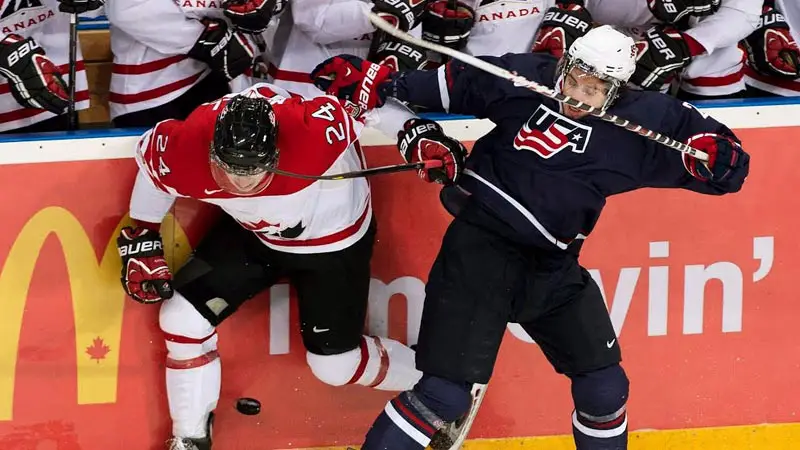The NHL Entry Draft is an exciting event where dreams are realized, and the future of hockey takes shape.
It’s a complex process that involves careful scouting, strategic decision-making, and a touch of luck.
This comprehensive guide will take you through everything you need to know about the NHL Entry Draft, from eligibility requirements to draft strategies and the historical significance of this annual event.
What is the NHL Entry Draft?
The NHL Entry Draft is an annual event where all 32 NHL teams have the opportunity to select rights to amateur hockey players who meet specific age criteria.
Think of it as a talent selection process where teams aim to identify and secure the rights to the most promising young players worldwide.
The draft consists of seven rounds, and each team gets one pick per round, resulting in a total of 217 drafted players.
The draft order is determined by a combination of a lottery system and the previous season’s standings, ensuring fairness and preventing teams from intentionally losing games to get higher draft picks.
Who is Eligible for the NHL Entry Draft?
To be eligible for the NHL Entry Draft, players must meet specific age requirements. All players must be at least 18 years old on or before September 15th of the draft year.
However, there’s also an upper age limit. Players cannot be older than 20 years old before December 31st of the draft year.
This age restriction applies primarily to North American players. Non-North American players over the age of 20 are still eligible for the draft.
Players who are older than the 20-year-old limit can still make it to the NHL, but they will have to be signed as free agents directly by NHL teams.
Where Do Draft-Eligible Players Come From?
The NHL Entry Draft draws talent from three main sources:
Major Junior Hockey Leagues

These leagues, primarily located in Canada and the USA, are a significant breeding ground for future NHL stars. N
otable leagues include the Canadian Hockey League (CHL), which comprises the Western Hockey League (WHL), Ontario Hockey League (OHL), and Quebec Major Junior Hockey League (QMJHL), as well as the United States Hockey League (USHL), and various Canadian provincial junior hockey leagues.
European Leagues
European junior and senior men’s hockey leagues are another critical source of talent for the NHL. Many European players develop their skills in these leagues before making the jump to North America.
NCAA Teams
College hockey in the United States, particularly within the NCAA, provides a pathway for players to develop both academically and athletically before pursuing a professional career in the NHL.
Understanding the Draft Order
The draft order is a crucial element of the NHL Entry Draft, and it’s determined in a way that combines competitive balance with an element of chance. Let’s break down how the draft order works for different rounds:
Rounds 2 Through 7
For rounds two through seven, the draft order is straightforward and based on the previous season’s performance.
Teams are ranked in reverse order of their regular season record, meaning the team with the worst record gets the first pick in the second round, followed by the team with the second-worst record, and so on.
This continues through all seven rounds, ensuring that teams with poorer records get the first chance to select players in these rounds.
Round 1 and The Weighted Lottery
Round one is where things get a little more interesting with the introduction of a weighted lottery system. The lottery is designed to give teams that missed the playoffs a chance to secure a higher draft pick.
The 16 teams that didn’t make the playoffs enter the lottery, and the top two winners have the opportunity to move up a maximum of 10 spots in the draft order.
This means that even a team that finished near the bottom of the standings could potentially land a top-three pick.
Preventing Tanking:
The weighted lottery system was introduced in 1995 to discourage teams from intentionally losing games, or “tanking,” to secure better draft picks.
By giving every non-playoff team a chance to move up in the draft, even if their record is not the worst, the NHL aimed to create a more competitive environment where teams are incentivized to win games throughout the season.
Trading Draft Picks: A Key Strategic Tool

Draft picks are valuable assets for NHL teams, and they are often used in trades to acquire established players or to move up or down in the draft order. This practice adds another layer of complexity and excitement to the draft process.
Trade Deadline Frenzy
A common time for trades involving draft picks is the NHL trade deadline, which typically occurs in March, about six weeks before the playoffs begin.
Teams looking to make a strong playoff push may be willing to trade away future draft picks in exchange for a player who can immediately contribute to their roster.
Value of Picks
The value of draft picks varies depending on their position in the draft. First-round picks are considered the most valuable as they offer the highest probability of landing a future star player.
Later-round picks carry more risk but can still yield valuable players who contribute to a team’s success.
What Happens After a Player is Drafted?
Being drafted is just the first step in a long journey for young hockey players. Here’s what typically happens after a player’s name is called at the NHL Entry Draft:
Signing an Entry-Level Contract
NHL teams have a limited time to sign players they’ve drafted. For players drafted from junior leagues or Europe, teams have two years to sign them to an entry-level contract.
If a player is not signed within those two years, they can re-enter the draft if they are still age-eligible. If they are too old to be drafted again, they become unrestricted free agents, meaning they can sign with any NHL team.
NCAA Players
Teams retain the rights to NCAA players for a longer period, typically until 30 days after they leave school. This gives NCAA players time to complete their education before deciding whether to pursue a professional hockey career.
Development and the Path to the NHL
Most drafted players don’t immediately jump into the NHL. They often continue to develop their skills in junior leagues, European leagues, or the American Hockey League (AHL), which is the NHL’s primary minor league.
The AHL serves as a proving ground for young prospects, allowing them to adapt to the professional game and refine their skills before making the step up to the NHL.
Draft Strategies and Considerations
NHL teams approach the draft with specific strategies in mind, aiming to build a competitive roster for the future. Here are some key considerations that factor into their decision-making:
Positional Needs
Teams carefully assess their current roster and identify positions where they need to add depth or talent. If a team is weak at defense, they may prioritize drafting defensemen.
Conversely, if they have a surplus of forwards, they might focus on drafting a goalie or a defenseman.
Chances of Making it to the NHL

The NHL Entry Draft is a hopeful time for young players, but the reality is that not every drafted player will make it to the NHL. The chances of making the NHL vary significantly depending on the round in which a player is drafted.
First-Round Success Rate
Players selected in the first round have the highest probability of reaching the NHL. Historically, around 66.7% of first-round picks have played at least 100 NHL games.
This indicates that teams are generally successful in identifying future NHL players in the early stages of the draft.
Declining Odds in Later Rounds
As you move into later rounds of the draft, the odds of making the NHL decrease considerably. For example, only about 7% of seventh-round picks have played at least 100 NHL games.
This highlights the increasing uncertainty and the importance of player development in later rounds.
Hidden Gems
While the odds favor early-round picks, there are always exceptions to the rule. Every year, players drafted in later rounds defy the odds and make a significant impact in the NHL.
Nikita Kucherov, drafted 58th overall, and Johnny Gaudreau, drafted 104th overall, are prime examples of players who were overlooked in the early rounds but went on to become NHL stars.
Historical Significance and Notable Draft Picks
The NHL Entry Draft has a rich history, and it has been the stage for selecting some of the most iconic players in hockey history.
The first overall pick is always highly anticipated, and many players selected first overall have gone on to have Hall of Fame careers.
Legendary First Overall Picks:
- Alex Ovechkin (2004): Considered one of the greatest goal scorers of all time, Ovechkin has consistently dominated the NHL since his draft year.
- Sidney Crosby (2005): Known for his exceptional playmaking abilities and leadership, Crosby has led the Pittsburgh Penguins to three Stanley Cup championships.
- Connor McDavid (2015): Widely regarded as the most talented player in the world, McDavid has captivated fans with his speed, skill, and scoring prowess.
The Importance of Scouting and Player Development
The NHL Entry Draft is just the beginning of a player’s journey. The success of a draft pick depends heavily on the quality of scouting and the effectiveness of player development programs.
Scouting
NHL scouts play a crucial role in identifying and evaluating potential draft picks. They travel extensively, watching games at various levels, from junior hockey to European leagues and NCAA games.
Scouts assess players’ skills, physical attributes, hockey IQ, and character, providing valuable information to their respective teams.
Player Development
Once a player is drafted, the focus shifts to player development. NHL teams have dedicated development staffs that work closely with prospects to help them reach their full potential.
This involves providing coaching, strength and conditioning programs, and opportunities to compete at higher levels.
The AHL plays a significant role in player development, allowing prospects to adapt to the professional game and refine their skills before making the jump to the NHL.
Conclusion
The NHL Entry Draft is a complex and fascinating event that shapes the future of NHL teams. From the weighted lottery system to draft-day trades and the challenges of player development, the draft is a multifaceted process that requires careful planning, strategic thinking, and a bit of luck.
The draft offers hope for young players dreaming of reaching the NHL and excitement for fans who eagerly anticipate the arrival of the next generation of hockey stars.





James Felix